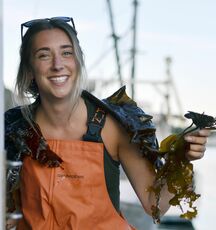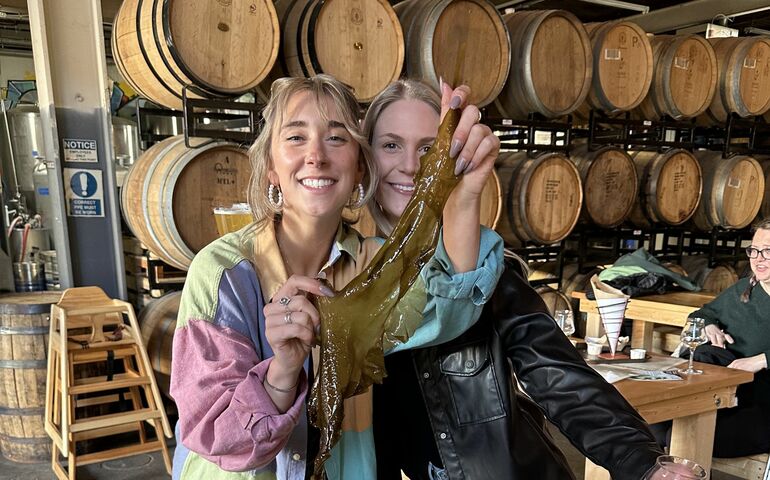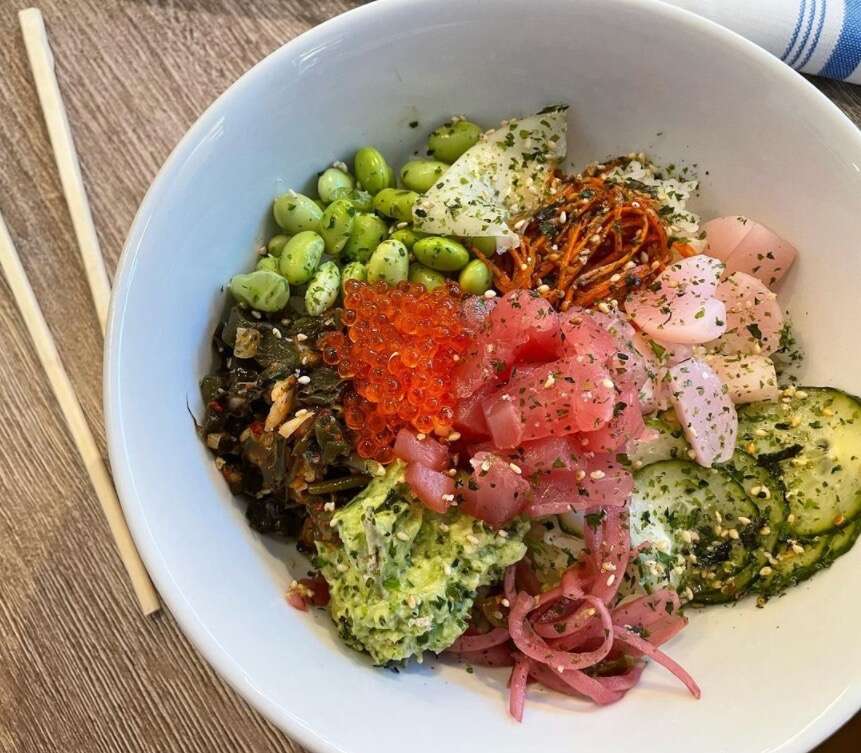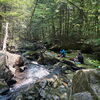
Processing Your Payment
Please do not leave this page until complete. This can take a few moments.
- News
-
Editions
View Digital Editions
Biweekly Issues
- December 1, 2025
- Nov. 17, 2025
- November 03, 2025
- October 20, 2025
- October 6, 2025
- September 22, 2025
- + More
Special Editions
- Lists
- Viewpoints
-
Our Events
Event Info
Award Honorees
- Calendar
- Biz Marketplace
Celebrating all things seaweed from chocolate to cheese as Maine hosts industry events
 Courtesy / Maine Sea Grant
Seaweed Week kicked off with a party at Oxbow Brewing Co. in Portland.
Courtesy / Maine Sea Grant
Seaweed Week kicked off with a party at Oxbow Brewing Co. in Portland.
More Information
Production of Maine seaweed is projected to hit 1 million pounds this year as the industry showcases products, research and innovations at two major events this month.
The fifth annual Seaweed Week kicked off last week across the state, with over 60 businesses — including bars, restaurants, breweries and distilleries — participating in the 10-day local food and beverage celebration until April 30.
The National Seaweed Symposium is also being held — for the first time in Maine. It began Monday and will go until April 27. The symposium convenes industry, regulatory, academic, professional and community leaders to discuss innovation and research in the U.S. seaweed sector.
“The numbers have been pretty exponential,” Jaclyn Robidoux, a marine extension associate and seaweed specialist with Maine Sea Grant and the University of Maine Cooperative Extension, told Mainebiz.

A decade ago, Maine had only a handful of early-stage seaweed farms. The farmed sector has seen substantial growth in production and, just five years ago, was only in the 30,000- to 50,000-pound range.
“Part of that was because we didn’t have the same kind of investment in processing and product development,” said Robidoux, an organizer of Maine Seaweed Week and the National Seaweed Symposium.
Today, Maine has over 40 commercial farms. Most produce sugar kelp. Some produce a similar variety called skinny kelp, and also winged kelp, also called alaria, that grows in colder water.
Sugar and skinny kelp go into fresh products such as kelp cubes and Sea-Chi kimchi produced by Atlantic Sea Farms in Biddeford.
Alaria has a different flavor and nutritional profile and is frequently sold as a dried product, said Robidoux.
Over 60% of the nation’s farmed kelp comes out of Maine waters. The majority of that is farmed by Maine fishermen in partnership with Atlantic Sea Farms in Biddeford.
In sync with the increase in farms, the processing sector has grown, too.
“It’s the whole supply chain, not just the production of the crop itself,” said Robidoux.
That includes land-based nurseries that produce baby kelp that go to the farms, and also working waterfront infrastructure.
Kelp grows in the winter and is harvested in the spring, providing a window of opportunity for harvesters in the wild fisheries, such as lobster, that don’t generally operate during that time.
Maine’s seaweed industry also includes the harvest of wild rockweed and other wild species — a much larger segment amounting to millions of pounds per year and dating back decades, Robidoux noted. Applications include fertilizer and human and animal health supplements. The wild harvest occurs in the intertidal zone, whereas seaweed farming takes place in state waters.
The intertidal zone is where the ocean meets the land between high tide and low tide.
Maine’s seaweed farms typically have two to three employees throughout the year, with additional hiring during the harvest season, Robidoux said.
A full economic analysis of the industry hasn’t been conducted, but it’s estimated that some Maine seaweed farms generate millions of dollars in business, she said.
Interest in the sector appears to be growing as Maine has a variety of sea farmer training programs.
“We’ve seen a big uptick in folks interested in starting farms” for various types of seafood, said Robidoux. For example, one class, designed for commercial fishermen or folks who are otherwise employed in marine industries, in years past had an attendance of 30 to 40. This year, enrollment is over 100, she said. The industry is seeing participation by women trending up, she added. And while most students in the past were interested in farming shellfish, more people today are interested in farming seaweed.
Maine is a farmed seaweed hub for a variety of reasons, she said. That includes its cold, pristine water, necessary for farming kelp, which is a cold-water species.
Thanks to its maritime heritage, Maine has working waterfront infrastructure and professionals with years of expertise working on the water. The longtime wild seaweed industry has lent its expertise to the farmed sector. Maine also already has a strong seafood brand.
Seaweed Week
Maine’s fifth annual Seaweed Week features more than 60 businesses, including bars, restaurants, breweries, distilleries and other artisans participating in the local food and beverage celebration until April 30.
Products include kelp food, drinks, crafts and events — from burgers and beer, cheese and salads, to chocolates and craft cocktails — featuring Maine-produced seaweed.
Launched in 2019 by Portland retail shop Heritage Seaweed and partners, Maine Seaweed Week was established to highlight culinary uses for local seaweed, as well as seaweed products coming out of Maine.
“We wanted to create a fun, annual tradition that celebrates Maine’s spring kelp harvest and gets folks excited about trying seaweed, and nobody is better at that than Maine chefs, brewers, and makers,” said Robidoux.
The festival is organized by Maine Sea Grant, Maine Aquaculture Association and Heritage Seaweed.
For more information, click here.
National Seaweed Symposium
The National Seaweed Symposium is convening industry, regulatory, academic, professional and community leaders to advance innovation and research in the U.S. seaweed sector. It began Monday and runs through April 27 in Portland.
Scheduled to coincide with Seaweed Week, the three-day symposium offers field trips, presentations and an interactive Seaweed Showcase featuring unique seaweed products, research, gear demos and materials.

Today’s sessions included a report on the National Sea Grant Seaweed Hub and a state-by-state overview of seaweed farming in the U.S., a keynote address titled “Seaweed for Community and Culture,” and sessions on other topics such as regulations, production systems, and economics and business planning.
Wednesday will feature field trips, including boat tours to kelp farms, looks at Portland’s working waterfront infrastructure, processing and cooking workshops, and walking tours to local food and beverage businesses working to bring seaweed to consumers. A seaweed showcase will feature seaweed businesses, product producers, researchers, nonprofit organizations and more.
Thursday’s program includes sessions such as post-harvest and processing, market opportunities, global production and innovation, and seaweed’s emerging role in climate and blue carbon initiatives and efforts in the U.S.
For the full schedule, click here.
Mainebiz web partners

The Giving Guide
The Giving Guide helps nonprofits have the opportunity to showcase and differentiate their organizations so that businesses better understand how they can contribute to a nonprofit’s mission and work.
Learn More
Work for ME
Work for ME is a workforce development tool to help Maine’s employers target Maine’s emerging workforce. Work for ME highlights each industry, its impact on Maine’s economy, the jobs available to entry-level workers, the training and education needed to get a career started.
Learn More
Groundbreaking Maine
Whether you’re a developer, financer, architect, or industry enthusiast, Groundbreaking Maine is crafted to be your go-to source for valuable insights in Maine’s real estate and construction community.
Learn more-
The Giving Guide
The Giving Guide helps nonprofits have the opportunity to showcase and differentiate their organizations so that businesses better understand how they can contribute to a nonprofit’s mission and work.
-
Work for ME
Work for ME is a workforce development tool to help Maine’s employers target Maine’s emerging workforce. Work for ME highlights each industry, its impact on Maine’s economy, the jobs available to entry-level workers, the training and education needed to get a career started.
-
Groundbreaking Maine
Whether you’re a developer, financer, architect, or industry enthusiast, Groundbreaking Maine is crafted to be your go-to source for valuable insights in Maine’s real estate and construction community.
ABOUT
NEW ENGLAND BUSINESS MEDIA SITES
No articles left
Get access now
In order to use this feature, we need some information from you. You can also login or register for a free account.
By clicking submit you are agreeing to our cookie usage and Privacy Policy
Already have an account? Login
Already have an account? Login
Want to create an account? Register
Get access now
In order to use this feature, we need some information from you. You can also login or register for a free account.
By clicking submit you are agreeing to our cookie usage and Privacy Policy
Already have an account? Login
Already have an account? Login
Want to create an account? Register







0 Comments